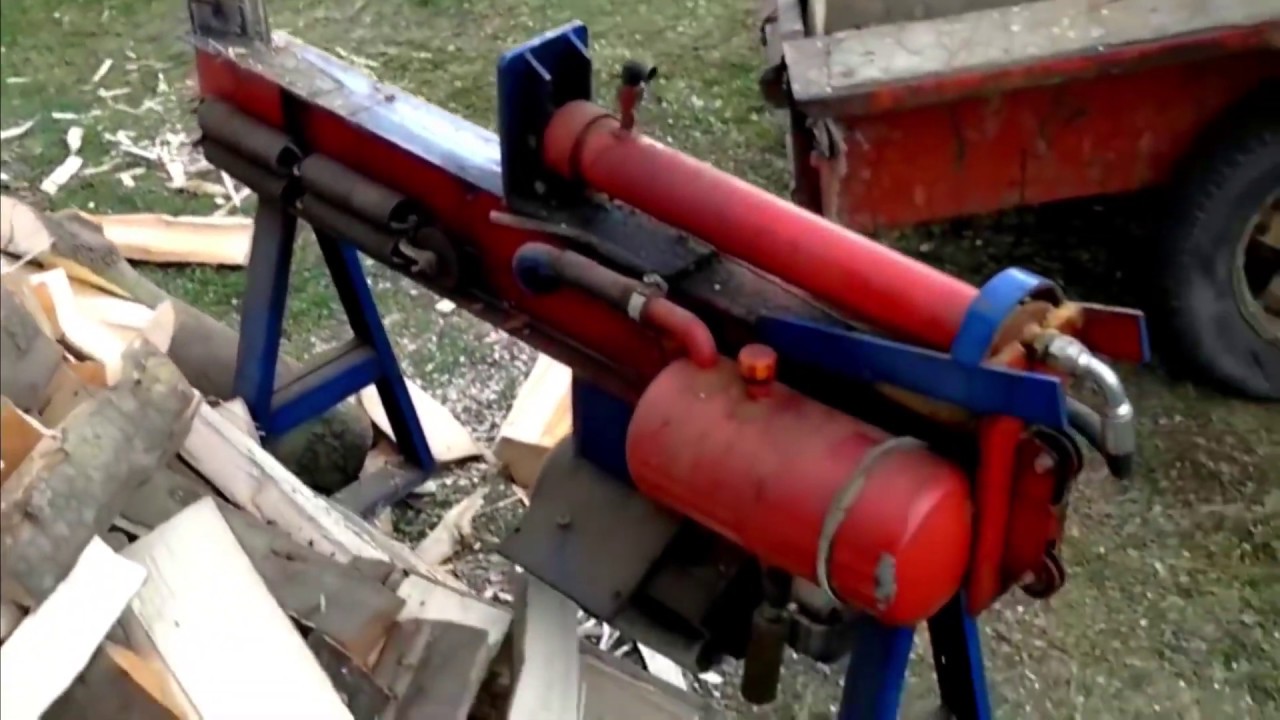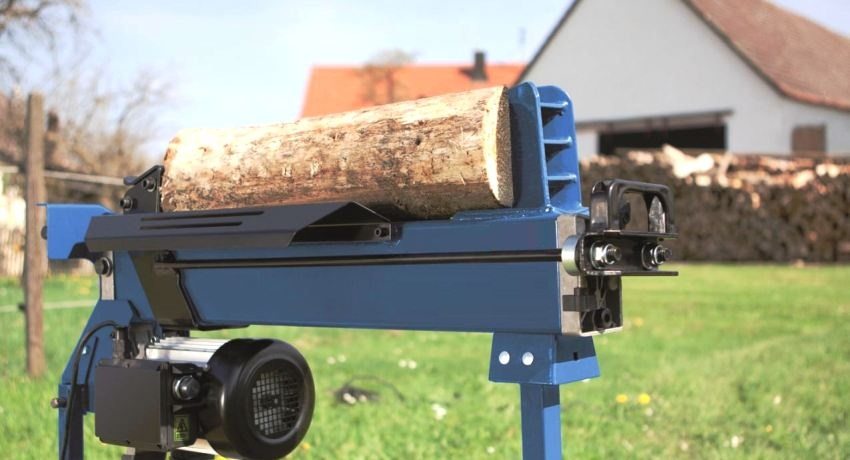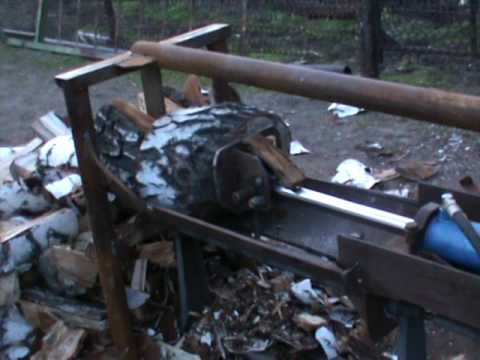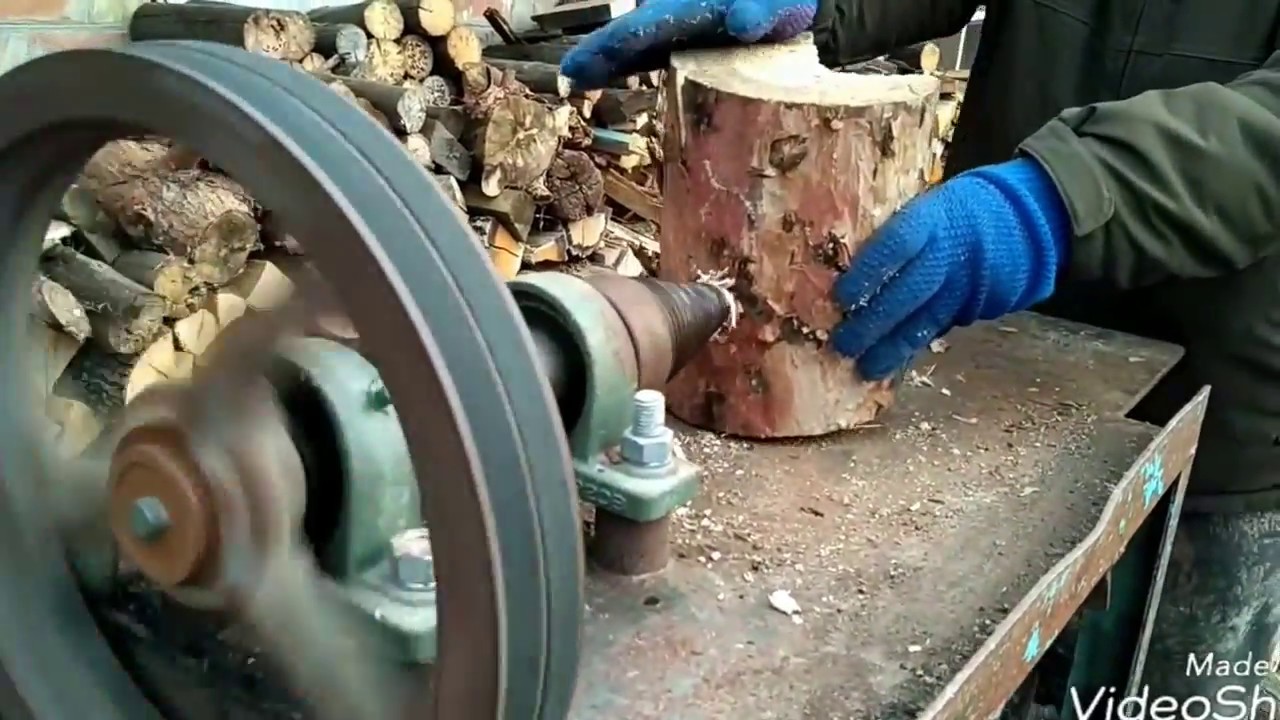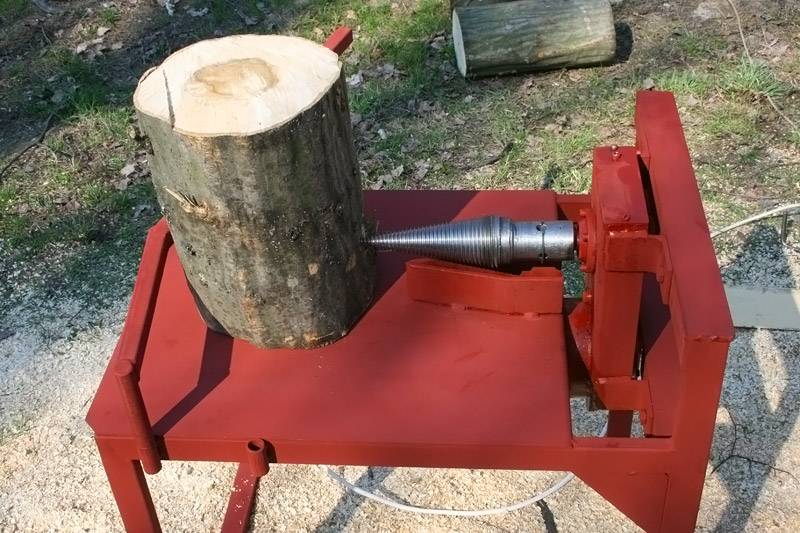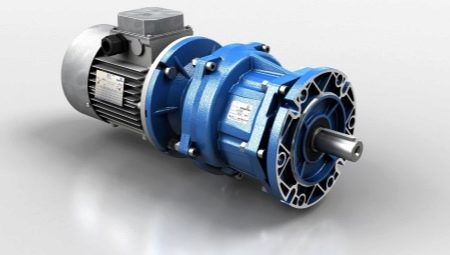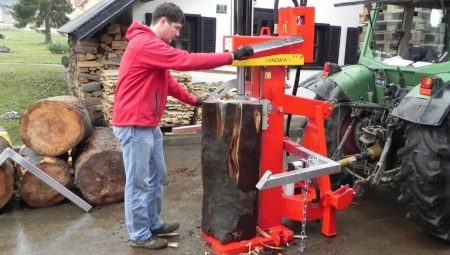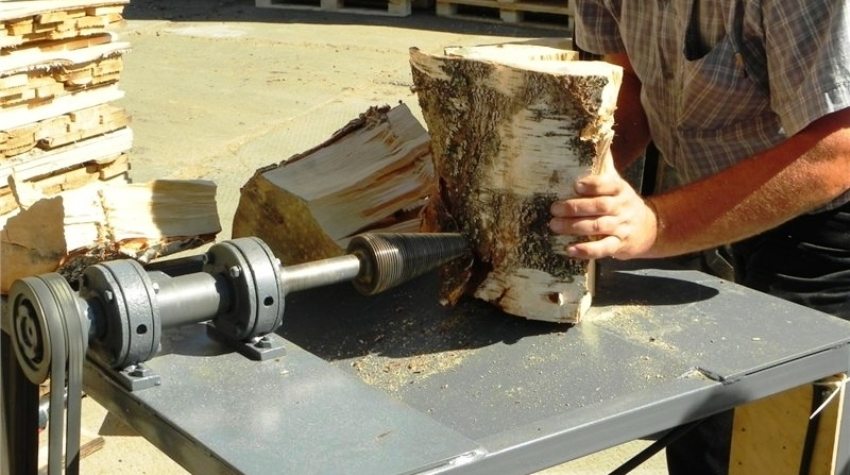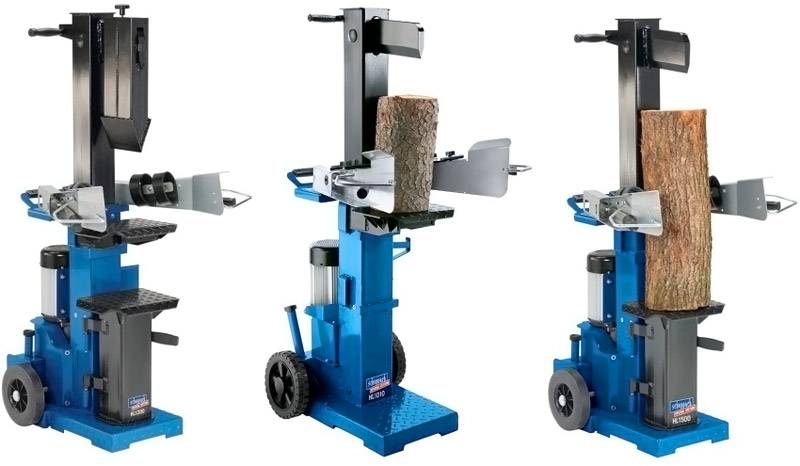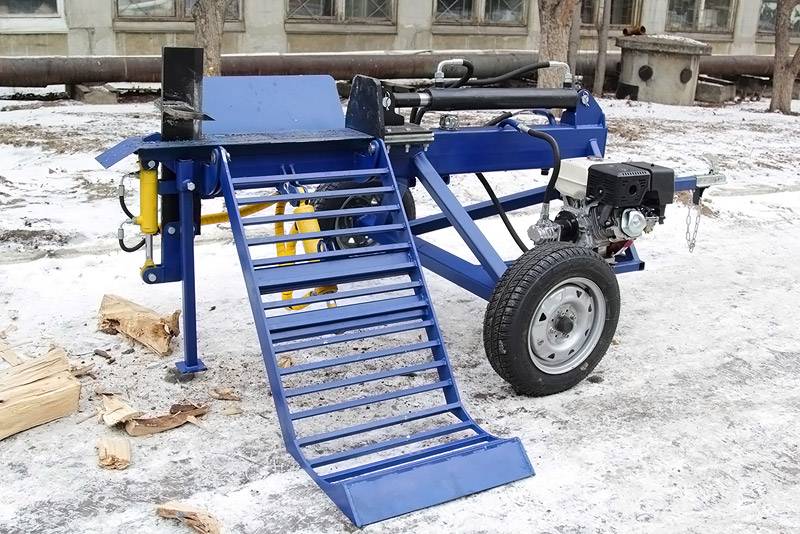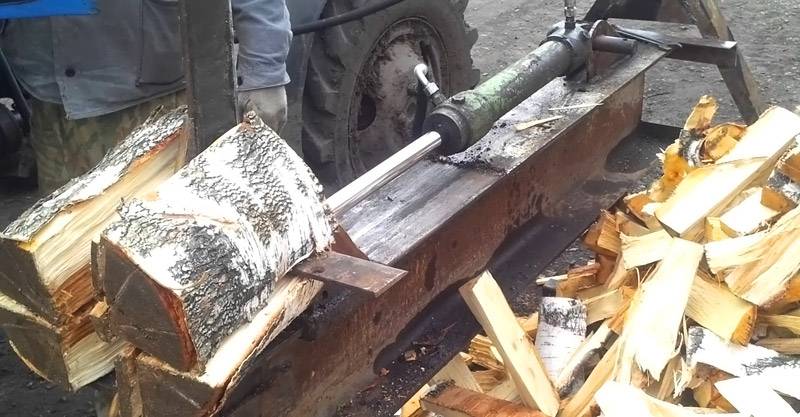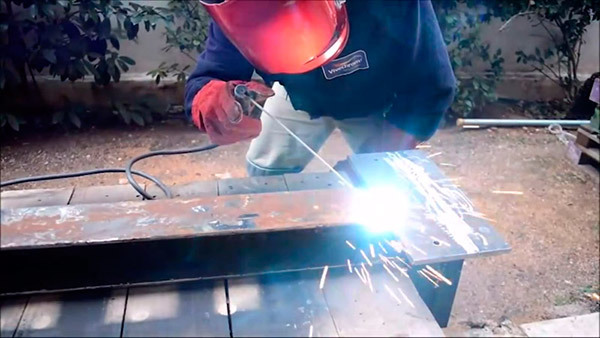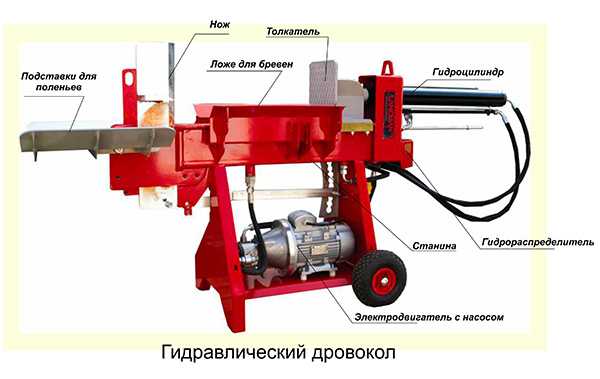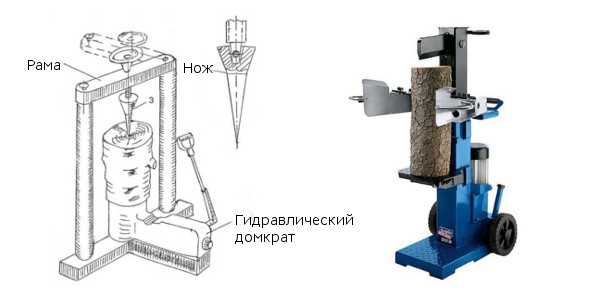Main characteristics
The cleaver is not in the full sense of the ax, but it is directly related to it.
The hand tool has an ax which is fitted with a wedge-shaped working part (head) without sharp sharpening.
The cleaver is designed for a single blow, after which the block will split into pieces.
It is not the sharpening of the blade that is important here, but the force of the blow.
Outwardly, the cleaver looks more like a sledgehammer than a classic ax.
One side of the head is flat (butt), and the opposite is wedge-shaped, made in the form of a two-sided cut at an angle of 40-50 degrees.
The weight of the cleaver reaches 5 kg, which allows him to cope even with large logs.
The meaning of this design lies not in cutting through the wood fibers, but in their delamination.
The thickness and length of the ax depends primarily on the size of the cleaver's head.
At the same time, the size of the handle directly affects the efficiency of the work, since a long hatchet paired with a heavy head concentrates a decent impact force on a small area.
Blade
As already mentioned, the cleaver blade is not sharp.
Depending on the shape, there are wedge-shaped (wedge-shaped) and eared options.
The second type, as the summer residents themselves note, is much inferior to the wedge-shaped cleaver in terms of convenience of work.
It is noted that the head, due to the presence of the "ears" set apart, often gets stuck in the logs, after which it is difficult to remove it.
The manufacturers themselves respond to this claim by the fact that such a design is designed to work with dry wood.
In reality, the owners of a private house use a tool to split raw, recently cut logs, which is incorrect.
The piercing edge is straight and rounded.
The first variant of the cleaver is suitable for working with large dry logs.
The rounded blade has a larger size, which makes it possible to cope with tarry and damp wood.
The cleaver's head is made by the following methods:
• Stamping
Medium carbon steel is used.
In most cases, forged cleavers weigh more than 2.5kg, and their center of gravity is concentrated in the head. This allows you to use such a tool for working with large logs.
• Casting
The blade is made of hardened steel and is usually smaller than the one mentioned above.
They are both straight and rounded.
Cast cleavers are more like an ax.
Handle
The wooden ax is a classic.
It has always been used, it will remain relevant for more than one decade.
Unlike metal, wood has the useful property of absorbing shock and vibration.
In addition, wooden handles are relatively cheap and easy to manufacture.
All this affects the cost of the instrument for the better.
However, among the minuses, it is worth noting the fact that the handle, with the wrong technique of working with the cleaver, splits.
An alternative to wood is fiberglass - a composite material with good strength indicators.
Some models are produced with a rubberized handle, thereby increasing the convenience of work.
At the same time, it is lightweight, which allows you to shift the center of gravity of the instrument towards the head.
The fiberglass handle is a suitable solution for heavy cleavers.
Step-by-step instructions: assembly features
At home, you can assemble any wood splitter with your own hands: drawings, photos, instructions will help you do it right. Each model requires a different approach.
From the description it is clear that the rack structure can be assembled by hand.To do this, it is worth adhering to certain recommendations and the sequence of work:
| Image | Stages of work |
| Drawing selection. | |
| Preparation of the necessary materials. | |
| Assembly of the bed. An important element is the supporting frame, it is made of a channel, an I-beam or a profile pipe. | |
| Installation of structural parts. The push mechanism is being installed. Additional parts can be installed: thermal relay, protective sleeve. | |
| The cleaver should be chosen with a four-cutter. |
It is better to equip the rack and pinion unit with a horizontal laying device, which is made in the form of a gutter.
The assembly of the hydraulic model is complex due to the mechanism. You will need to find an oil tank, a special cylinder, a control unit for fluid flows and pumping equipment.
Hydraulic model device
First of all, the frame is made. It is best mounted on wheels or chassis to move the device to the desired location. The main hydraulic part is attached to the frame. Instead of a knife, a tapered wedge is adapted, which moves to the log using a central screw.
Schematic diagram of the hydraulic unit
Cleavers with engines are characterized by greater productivity. For their installation, a hydraulic cylinder, an oil tank, a control unit and an electric motor are required. Such a device works faster than a mechanism with a jack. This requires less effort.
Using the control button, a command is transmitted to the distribution device to supply fluid to the cylinder cavity. As a result, the stubborn heel moves in the desired direction.
The main components of the unit
This design does not have a high speed of operation, but it has a certain convenience.
How to build a model of a screw wood splitter with your own hands: drawings
The easiest way is to assemble the screw unit yourself. To do this, you need to buy a screw cone for a wood splitter. You will also need a powerful motor, a sturdy frame, a reduction gear and a shaft.
This is how a homemade unit works
First of all, the motor and the gearbox are mounted to the frame. A cone is attached to the shaft, and the mechanism itself is connected to the reduction gear using a motor. When assembling, there are important points to consider:
- the nozzle cannot be directly mounted to the motor;
- if there are no electrician skills, then electrical mechanisms should be made by a highly qualified specialist;
- belt and chain drives are protected by a special casing;
- the minimum rotation speed of the cleaver is 250-300 rpm.
Homemade screw model
This type of wood splitter works with a rotating metal cone that splits the logs using a special thread. When assembling a screw model with a cone-shaped splitter, it is necessary to select the correct cone depending on the logs used. The base for the device looks like a working platform with a fixed splitter shaft. A keel is welded to the table to avoid particles getting under the rotating mechanism. Power supports are mounted, and the cleaver is set in working position. Then the motor is connected.
Simple DIY installation device
The model of a wood splitter with a washing machine engine is popular. Three types of motors can be used: asynchronous, brushed or electronically controlled. Asynchronous motors are considered the most common option. Older models have a separate winding for starting.
The motor from the washing machine is great for building a wood splitter
Homemade wood splitter
Do you use homemade wood splitters when preparing firewood?
Not really
Even for the simplest manual device, the store asks for several thousand rubles. You can save money by making a cleaver for their firewood forces. For clarity, it is worth studying the video with different machines in operation.
Drawings and manufacturing of a rack-and-pinion wood splitter
There are several variations on how to make a log splitter. One of them is a rack and pinion design.It is popular because the Internet offers a lot of photo instructions.
For work, you need to prepare a grinder and a welding machine. The gearbox is made of an electric motor (at least 2 kW) and two pulleys.
The base of the device must be made of thick steel. It must withstand the load and the weight of the components attached to it - the wedge, the gearbox and the motor.
The working algorithm depends on the selected materials, the device diagram. The main steps are as follows:
- Cut the edge out of sheet steel. Minimum thickness 10 mm, sharpen at right angles.
- For large logs, make a split blade. Thickness from 50 mm. As an amplifier, you can use a steel blank.
- Place the gear 5 cm above the bed. There should be double the length of the log to the knife.
- Run the carriage, moving along the bed, at the height of the installed gear.
- Attach the pusher to the front of the carriage. It is a transverse steel plate with a minimum thickness of 7mm.
- Ensure the mobility of the rail with the hinge by placing it on the carriage.
- The movement of the carriage to the gearbox is provided by a return spring. Attach it so that the rack rises above the gear.
- Install the pressure arm. When you press on it, the rack should be pressed against the gear and move forward. Make the length of the rail less than the gap between the blade and the feed plate.
Hydraulic wood splitter drawings
If you plan to make a hydraulic log splitter on your own, you need to decide what kind of wood it will be used for.
With a cleaver speed of 4 cm / s and an apex angle of 20 °, the indicators are as follows:
| Wood species | Average force in kN | ||
| Diameter 200 mm | 300 mm | 400 mm | |
| Birch | 16 | 29 | 48 |
| Elm | 28 | 39 | 65 |
| Oak | 24 | 33 | 51 |
| Spruce | 11 | 18 | 26 |
| Maple | 18 | 10 | 49 |
| Linden | 3 | 4 | 6 |
| Aspen | 10 | 17 | 26 |
| Pine | 8 | 15 | 24 |
The indicators differ significantly. If the logs are very knotty, the load is at least doubled.
For a hydraulic home-made device, you need to prepare:
- electric engine (possible on gasoline), at least 2 kW;
- Control block;
- pump;
- oil filling tank (you can make it yourself);
- high-pressure hoses;
- hydraulic cylinder;
- beam (metal), U-shaped or I-beam No. 16;
- sheet steel, prepare pieces with a thickness of 5-20 mm;
- metal corner, shelf 30-40 mm.
A hydraulic cleaver is made on its own according to the following algorithm:
- Make the bed using a U-beam or I-beam. An important point is the width of the beam. With its increase, the permissible load increases, but the movement of the structure becomes more complicated. The average is 10-15 cm.
- Install a hydraulic cylinder over the beam, height 5-7 cm.
- End the stem with a pusher. It is better to use metal, thickness 7-10 mm.
- To move the knife along the bed, make a body.
- To fix the knife in different positions, make 12 mm holes at the bottom of the bed, 50 mm increments. Add 2 holes in the blade body in the same way, install 2 bolts, weld them.
It remains to close the hydraulic circuit.
Installation of the hydraulic device
The assembly of the mechanism is complex. To create a wood splitter, you will need a special cylinder, an oil tank and a fluid flow control unit. First, a frame is made, for greater convenience it can be mounted on wheels or a special chassis. This will allow you to move your device from one point to another, making it mobile.
The main hydraulics will be attached to the frame. You can make a sound-absorbing gasket under the base. It will help to slightly reduce the noise level in the process, remove unnecessary friction between the frame and the hydraulic unit. A screw is installed in the center, which will move towards the log.
The presence of an electric motor in the device allows you to speed up the process and significantly simplify the stage-by-stage execution. Such a device will work much faster than a mechanism with a conventional jack. When finishing wood, less manual force will be involved than when using a mechanism with a motor.
> If we talk about the differences between the factory model and the unit made by hand, then they will not have much difference. The only exceptions are price indicators. Models from the factory cost several times higher than those made on their own, but the power of the former will also be higher. Everyone chooses convenient options for himself, but if there is an opportunity to create a design on his own, then this will help to significantly save the family budget.
Design and principle of operation
The hydraulic wood splitter consists of a frame, a stop, a hydraulic cylinder, a working blade, a pump, a fluid pressure distributor, an oil tank and an engine. The engine starts the hydraulic pump, which causes the piston to move. The knife plays the role of a cleaver and, under the influence of pressure, splits the workpiece. The chock is placed on a metal frame between the knife and the piston.
A distinctive feature of hydraulic devices from conventional mechanical ones is a smooth increase in force, with a lack of which the cylinder stops moving and does not force the engine to operate at high speeds. In mechanical models, a smooth increase in force does not occur. If the chock does not crack, the motor will still continue to run at full power, which leads to overheating of the engine and increases the risk of premature wear. On hydraulic models, if the cutter is unable to split the wood, the piston stops and the engine slows down and does not overheat.


Advantages and disadvantages of using a wood splitter
Surely not everyone clearly understands whether they need this unit, because most people chop wood by hand. Let's take a look at the main pros and cons of using this device and try to understand whether its purchase (construction) is advisable.
The advantages include:
- Minimum human involvement. All that is required of you is to make sure that all processes are running correctly and to deal with the supply of firewood. The log splitter will do the rest for you.
- Speed and efficiency. Naturally, an electrical device equipped with a motor works much faster and, unlike a human, does not require rest and breaks. Thanks to the possibility of continuous work, you will receive the required amount of firewood in a short period of time.
- Convenience. Using a wood splitter will save not only time, but also health, since during the work you will not even have to bend over. This fact will certainly delight people suffering from back pain.
- Operation at any time. The device must always be in good working order so that you can chop the required amount of firewood without any problems.
- Ease of use. Oddly enough, but even a fragile woman can cope with the device. The work does not require the use of brute force, so there will be no problems with the operation of the wood splitter.

A small electric wood splitter will help you to cope with wood chopping much faster

There are mobile wood splitters, these are usually trailers on wheels, with which you can chop wood anywhere
Of course, we must not forget about the shortcomings, which also have a place to be. These include:
- The design of the wood splitter is quite complex, especially when it comes to hydraulic models, so their care must be careful and timely. If any part fails, it may be difficult to replace it.
- Wood splitters are relatively expensive. But if you decide to build the device yourself, you can save a lot.
It's another matter if you have a whole farm at your disposal. In this case, the wood splitter will become your faithful assistant and will save a lot of time and effort. Those who are engaged in the industrial harvesting of firewood will also not be able to do without this device.
For a very small amount of work, it will be more economical to use a conventional cleaver ax
DIY hydrocracker
It is not difficult to make a hydraulic firewood splitter. The main snag is in its hydraulic part, diagram, connection methods and components calculation, which we will consider.
We will not consider the device of the case, desktop, wedge and the possibility of transportation and similar functions in detail, for the simple reason that they mainly depend on the imagination and needs of a particular master. They do not affect the main task of the cleaver. But we will give a number of general recommendations below.
The minimum of what the simplest hydraulic wood splitter can consist of is:
- hydraulic pump;
- hydraulic pump drive (engine);
- hydraulic valve;
- hydraulic tank;
- hydraulic cylinder;
- sleeves;
- connecting elements.
Before designing a home-made hydrosplitter, you need to decide on its power, namely, how much force the hydraulic cylinder is required. An error at this stage leads to the fact that the drive power may not be sufficient. Consequently, the engine will jam on knotty wood or large logs.
You can see the hydraulic diagram of a simple wood splitter in the photo. It includes a minimum of components
It is worth paying attention to the presence of its own safety valve at the hydraulic distributor. Its presence will not help in any way to improve or simplify the main task of the device, but it is always necessary to install it.
If the distributor does not have one, then the installation of an autonomous valve in the system is required.
It is necessary to understand well the rule of the inverse relationship between the performance of the hydraulic system and the required drive power. With such a calculation, in this scheme, you always have to sacrifice the speed of the hydraulic cylinder in favor of a lower engine power. But this does not always work. The industry requires a combination of both high speed of the hydrosplitter cycle and low power consumption. In this case, a peculiar type of load will help: a large idle stroke of the hydraulic cylinder and a short loaded mode. Here it is necessary to divide the flows to the hydraulic cylinder by capacity, depending on the operating mode.
The diagrams below solve a similar problem. Two pumps with different volumes from one drive or a double pump with different section volumes are taken into operation. For example, pumps NSh32 and NSh10 are presented.
The idling of the hydraulic cylinder is provided by the total flow of both pumps, the safety valve in this case is set to a pressure much less than that required to ensure the operating cycle (splitting). When the hydraulic cylinder rests against the workpiece, the increased pressure in the NSh32 hydraulic line is discharged through the safety valve into the tank, and the check valve restricts the hydraulic line only to the flow and generated pressure from the NSh10. The diagram shows the loaded hydraulic line from NSh10. After splitting the workpiece, the pressure in the system drops sharply and the safety valve closes and the cylinder is again fed with the total flow. All this leads to high performance of the cleaver in idle mode, as well as to saving power of the drive motor in loaded mode.
To use the solution of a hydraulic splitter with two pumps, we present a more complete, recommended scheme
Electric wood splitters
A manual wood splitter, of course, makes it easier to harvest firewood, but it still requires solid physical effort. Not so much as they are spent waving with an ordinary cleaver, but still ... The electric motor helps to make the efforts even less. On its basis, wood splitters of various designs are made. But making such a wood splitter with your own hands is more difficult. Here and the device is more complicated, and at least minimal knowledge of electricians is required - it is desirable to connect the motor through the starter, and with the buttons "start" and "start".
Screw (conical)
One of the most common models is a cone or screw log splitter.The difference between them is only in the absence / presence of threads on the piercing element, which in this model is made in the form of a cone.

The cone splitter speeds up the harvesting of firewood
Churbaks split due to the fact that the cone rotated by the motor cuts into the wood, gradually tearing it apart. In large logs, the edges are first chipped off, then the middle is torn apart.
Taper and thread options
First, the cutting part was turned into a smooth cone. If you use a smooth cone, you have to lean on the block rather strongly during work so that the cylinder "bites" into the wood. The process is much easier if a thread is cut on its surface. In this case, the block is somehow screwed onto the screw, and then cracks.

Dimensional drawing of threaded cone for screw wood splitter
The main thing is to correctly make a threaded cone. If you have a lathe and work experience, you can try to do it yourself. If not, you will have to order. The thread is made in different ways, but the following parameters are recognized as optimal: a step of 7 mm, a depth of 3 mm (minimum - 2 mm). Another important point is that the depth of the seat on the motor gearbox is at least 70 mm.

Wood splitter screw
If there is a threaded cone, it will not be difficult to make this wood splitter with your own hands.
Electric motor and gearbox
You need an electric motor powerful enough (2 kW and above or 5-9 l / s), but with a low speed: 250-600 rpm. At 250 rpm and below, it splits very slowly, and if the rpm is more than 500, it is dangerous to work, as it can pull the log out of the hands.

Wood splitter with a screw fitted directly to the crankshaft
If you managed to find an engine with such parameters, you can put the lance (screw) made directly onto the crankshaft (pictured above). If there are more revolutions, it is necessary to install a reduction gear or make a chain or belt drive to reduce the speed.
Calculate the ratio depending on the engine speed. For example, there is a 900 rpm engine. Having made a 1: 2 gearbox, we get 450 rpm. Just the best option.
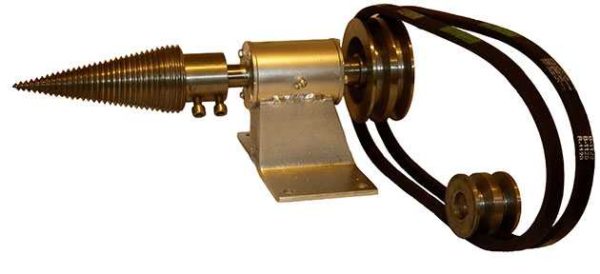
Reducing reducer for screw wood splitter
Transmissions can be belt or chain. Chains work many times louder, require constant strokes, and it is usually more expensive to carve sprockets with the necessary parameters. A double belt drive is desirable (as in the photo above). In this case, there will be less slippage.
Where to locate the motor
If the design provides for the presence of a transmission, it is better to put the motor below, and fix the screw itself on the working surface. Choose the height of the working surface for your height so that you do not have to work in an incline.

A safer model. Making such a wood splitter with your own hands will make your life much easier.
There is also such a parameter as the height of the screw above the working surface... The gap from the table to the cylinder should be in the region of 8-20 cm. It should not be placed higher - it can turn small-diameter blocks of wood. The optimal distance is 8-12 cm. Even small blocks of wood do not turn.
Hydraulic wood splitter
A hydraulic log splitter is the most powerful, but also the most difficult and expensive to manufacture. In addition to the bed, engine and cutting knives, a hydraulic cylinder with sufficient power is needed. They are not cheap. In addition, you also need an oil tank and a pump.

Hydraulic splitting device
A hydraulic splitter for firewood develops solid efforts, therefore, in its manufacture, metal of considerable thickness is used - 6-10 mm, depending on the drive power. The developed effort is quite enough to break the chock into 6-8 logs at a time. Therefore, knives are made in the form of an "asterisk".

A hydraulically driven cleaver is equipped with a complex cutter, which breaks a block of wood into several logs at once
When making knives, they are spaced a few centimeters apart. So that there is only one in the work.For example, first - horizontal, then - vertical, then - right and at the end - left. At the same time, reinforce each of the knives by welding reinforcing plates on the back. It is advisable to use hard steel, having previously sharpened it according to the same principle as on cleavers.
Views
The classification of hydraulic wood splitters is based on several criteria. The first of these is the functional accessory of the instrument. According to this criterion, two types of devices are distinguished.
Professional. They are represented by complex dimensional models that, in addition to splitting logs, have a number of useful functions. Such units are capable of feeding, trimming and even unloading firewood, which makes them versatile in logging production and allows them to replace several highly specialized machines at once. The devices are equipped with a powerful gasoline or diesel engine, and the hydraulic system is often supplied from the tractor PTO shaft. Professional models have a very high cutting speed and are able to easily cope with old and damp wood. Due to this, they are used for harvesting and mechanical crosscutting of timber at large logging points.




The next criterion for distinguishing wood splitters is the way the logs are laid. On this basis, there are three categories of devices.
Horizontal models are designed to accommodate and split chocks horizontally. Such devices represent the most numerous category of devices and are widely available for sale. The operation of such units can be performed in two ways. In the first case, the blade is motionlessly fixed in the bed, while the piston pushes the workpiece powerfully onto the knife. In the second version, the log is stationary, and the hydraulic drive moves the knife on it no less powerfully.

- Vertical devices have a mechanism absolutely identical to horizontal devices and differ from them only in its location in space. The chock is installed in a special gutter in a vertical position, after which it also splits vertically. In this case, the movement of the knife occurs from the bottom up. Vertical devices have a rather compact size and are very convenient for storage.
- Mixed models include both chocks. They are classified as professional equipment. Such devices are characterized by high performance and are used in large logging enterprises.


Let's make the results - which is better
We have already determined that performance and safety are the two main factors of choice - clearly in favor of a hydraulic log splitter.
So, its pros:
- Convenient to work;
- Safe;
- Productive. Especially with a powerful engine, excellent hydraulics and a cruciform knife;
- Creates tremendous gravity on a piece of wood;
- Works with large and heavy decks;
- There are two designs to choose from (horizontal and vertical).
But it's not that simple. These units also have disadvantages:
- They are more expensive because their structure is complicated by expensive hydraulics;
- The maintenance is also more difficult. Firstly, they have more mechanisms and working elements, and secondly, hydraulics are oil. Therefore, it requires regular replacement, which cannot be said about the screw wood splitter. But changing the oil is not a design problem, but a technical necessity. It's just that the mechanism itself does not work without it.
- These devices are larger in size and dimensions. Their weight is heavier. That's right, because they contain a whole hydraulic system with a pump, vice and clamps.
The undoubted advantages of the screw wood splitter:
- Simple construction. The cone unit is just an engine and a "carrot";
- It weighs a little, dimensions are compact;
- Can be mounted on the shaft of a tractor or walk-behind tractor;
- Low price.
Minuses:
- There is a danger of injury;
- Lower performance;
- Not so comfortable to work.
So which wood splitter is better: screw or hydraulic? Choose for yourself what is more important to you. What kind of indicators should your log splitter demonstrate? It all depends on the volume of firewood that needs to be chopped, on the size of the logs, their hardness, on where the installation will be - at home in a barn, or in the forest. Whether you are chopping firewood for yourself, or for sale - mass harvesting.
In general, there are plenty of conditions that influence the choice. You just need to clearly define them. In any case, remember that weight, price, ease of maintenance and compactness of the device will always be behind the cone splitter, and convenience, safety, productivity and practicality will always be behind the hydraulic one.


